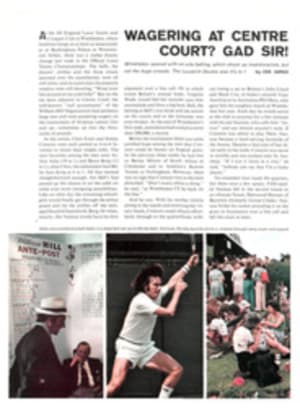
A BIG LEAP AND A LOT OF FAITH
Prize money on the professional freestyle skiing circuit more than tripled last year and there is every sign that the boom is just beginning. Forty-five top men competitors won $162,500 in 1975 and 20 women stars went from $12,500 in 1974 to $90,000 last season. There now are 2,000 freestylers on a B circuit and thousands more coming up in a young amateur group. Beyond that, says Curtis Oberhansly, president of Professional Freestyle Associates, "Enthusiasm for freestyle skiing in Europe is unbelievable. They are interested in four international competitions next year, one each in Iran and Japan and two on the continent. I think the future is worldwide for us."
Since Americans invented this game, the feeling is that U.S. skiers are about a year ahead of the competition, with West Germans, Austrians and the Japanese coming on fast. And by way of holding the lead, the U.S. is developing summer training centers across the country.
One of the camps is located at South Lake Tahoe, which appears the same as always at first glance: the water shimmers and reflects an azure sky, and stately ponderosas rise from the sandy shoreline. Then suddenly what seems to be a monster bird bursts skyward in a perfect Moebius somersault over the water. And kersplash. Any devoted freestyle ski nut would register instant recognition. It could only be a Bob Salerno, a Robert Young or a John Clendenin performing aerial stunts. Clendenin and Bill O'Leary, co-owners of the World Freestyle Training Center, claim, "We have the summer facilities for everything from tumbling to aerials, from basic snowplow to the most involved maneuvers in freestyle ballet skiing. We're trying to assemble the finest instructors and most complete facilities anywhere—an elite training center. Seventeen of our 20 top competitors work out here. Some trade an hour of teaching for an hour of training. Last year we trained about 200 people and this year it will be close to 1,000."
Penelope Street, a big prizewinner in winter, says of her training, "The ski deck is great; it gives me miles of skiing to get in shape before I get on the snow. My ballet improves, but it's the hours that count—it's like skiing 1,000 miles without stopping to get in a lift-line."
Instruction and training at Tahoe is available in several packages, with the camp operating seven days a week from 9 a.m. until 9 p.m. up to October. A one-week course offers an hour a day on the ski deck, an hour on the trampoline and a daily gymnastics class for $125. One can also buy a 10-hour course for $87.50 or a season pass for $265 that includes a minimum of one hour of deck and trampoline daily with all other facilities open.
"One hour a day on the ski deck is maximum for beginners because you are on your edges and working the whole time," says O'Leary. "It is concentrated and exhausting, comparable to skiing all day or maybe 15 miles without stopping." Clendenin says, "There is probably not a device in any sport that can get someone as far as fast as the deck. In an hour you learn how to use your edges and weight yourself over your skis."
Biggest danger on the 5-mph deck is from rug burns suffered in a fall. Some skiers wear gloves to protect their knuckles, others wear elbow and knee pads, but just about any piece of material between skier and carpet adds some protection. Still, most of the freestyle students flout the perils, preferring cut-offs or bikinis. They also get tan that way but, as one skier said, the real rationale is, "You tempt fate—you show that you know how to ski better than the carpet knows how to burn." Aerial instructors Darryl and Terry Ferges wear Australian motorcycle shirts with padded sleeves that they order from a New York store called The Chocolate Soup.
For mogul buffs, World Champ Chris Thorne uses the deck to teach pole plants, rhythm and balance atop the skis. In aerial instruction, Darryl Ferges says, "We teach in safe progressions, basic safety rules first. Before you do a double back flip you have to do a single back flip; before any flips you have to learn to go the way you are pointed. Many people get scared when they throw their heads back and can't see anything for a split second—that's what is known as a leap of faith. You have to commit yourself and go through that one before graduating to the mini-trampoline and the ski jump." Robert Young, this year's World Aerial Grand Prix champion, says, "Once you've learned balance you can begin learning tricks. This whole trip is for people who are capable of being aggressive and competitive. We get people in shape for competition." For Young, going off the jump is "exhilarating—almost the same feeling as three-meter diving. You're in the air for a long time, but you know that if you come down wrong, you're just coming down in water. Worst thing that can happen is that you'll sting for a while. We wear neoprene ski pants for protection and to keep warm—the water is about 65°. On the jump you get a chance to practice until a trick is natural and you're sure that the first time you do it on snow you're at least going to land upright. I know it saved me a year of training."
Clendenin, the 1974 World Freestyle champion, insists, "This isn't hotdogging anymore. I define hotdogging as skiing beyond one's ability—whether a beginner, intermediate or expert. I'm a professional freestyle skier. I approach my limits very cautiously with as much training as possible and a lot of fear—and when I cross my limits I'm very conscious of it and I want to get right back as soon as I can. You can't touch down in a professional freestyle contest and expect to be in the top 10 without skiing near that limit. But you have to stay this side of it. It's tough."

